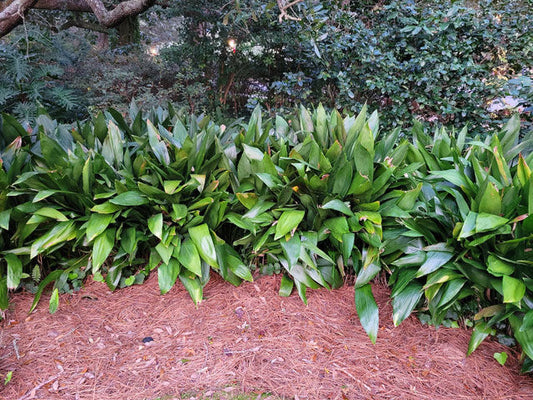

Why Choose the Cast Iron Plant?
The Cast Iron Plant is not just another green addition to your space; it's a symbol of strength and endurance. Here's why it stands out:
Shade Loving: While most plants crave sunlight, the Cast Iron Plant breaks the mold by thriving in low-light conditions, making it a perfect fit for those challenging, dim areas of your home or garden.
Low Maintenance: This plant's care routine is as easy as it gets. Forget the complex feeding schedules and delicate handling; the Cast Iron Plant is all about simplicity and ease.
Air Purification: Beyond its aesthetic appeal, the Cast Iron Plant is known for its ability to purify the air, making your home not just more beautiful but also healthier.
Evergreen Nature: With its evergreen leaves, the Cast Iron Plant ensures that you have a splash of color in your space throughout the year, even when other plants might wither away.
Directions for Planting/Care
Selecting the Right Spot
Finding the perfect spot is crucial for the Cast Iron Plant. It prefers low to medium light conditions and can even thrive under fluorescent lighting, making it ideal for offices and rooms without ample natural light. East-facing windows are perfect as they provide gentle morning light without the harsh intensity of direct afternoon sun.
Potting and Soil Requirements
A pot 12 to 14 inches in diameter with drainage holes is ideal for preventing water retention and root rot. The Cast Iron Plant is not fussy about soil but does require it to be well-draining. A mix of potting soil, peat, and perlite usually works well, providing the right balance of drainage and nutrient retention.
Watering Wisely
Overwatering is a common misstep in plant care, especially for the hardy Cast Iron Plant. Allow the topsoil to dry out completely between waterings. When the soil is dry to the touch, water deeply, letting the excess drain. This mimics the natural dry-wet cycle the plant experiences in its native habitat.
Feeding for Health
The Cast Iron Plant has modest nutritional needs. A balanced, water-soluble fertilizer once in the spring is generally sufficient to keep it healthy. Over-fertilization can do more harm than good, so it's best to stick to this minimal feeding schedule.
Temperature and Humidity
This plant is not particularly demanding about temperature or humidity. Average indoor temperatures and humidity levels are usually adequate. However, it's worth noting that it doesn't tolerate frost well, so it should be protected from extreme cold if kept outside in cooler climates.
The Cast Iron Plant (Aspidistra elatior) is more than just a plant; it's a testament to resilience, a statement of understated elegance, and a breath of fresh air in your living space. Its ability to adapt to various conditions, coupled with its minimal care requirements, makes it an unbeatable choice for anyone looking to enhance their space with greenery. Embrace the strength and beauty of the Cast Iron Plant and let it transform your home or garden into a sanctuary of tranquility and style.
Frequently Asked Questions
How often should I repot my Cast Iron Plant?
What are the common issues to watch out for?
Is the Cast Iron Plant pet friendly?
Can it survive in artificial light?
Does the Cast Iron Plant have any pest problems?
What our customers say
Real reviews from real customers
People Also Bought
Here’s some of our most similar products people are buying. Click to discover trending style.
Recently Viewed
Don't forget! The products that you viewed. Add it to cart now.





